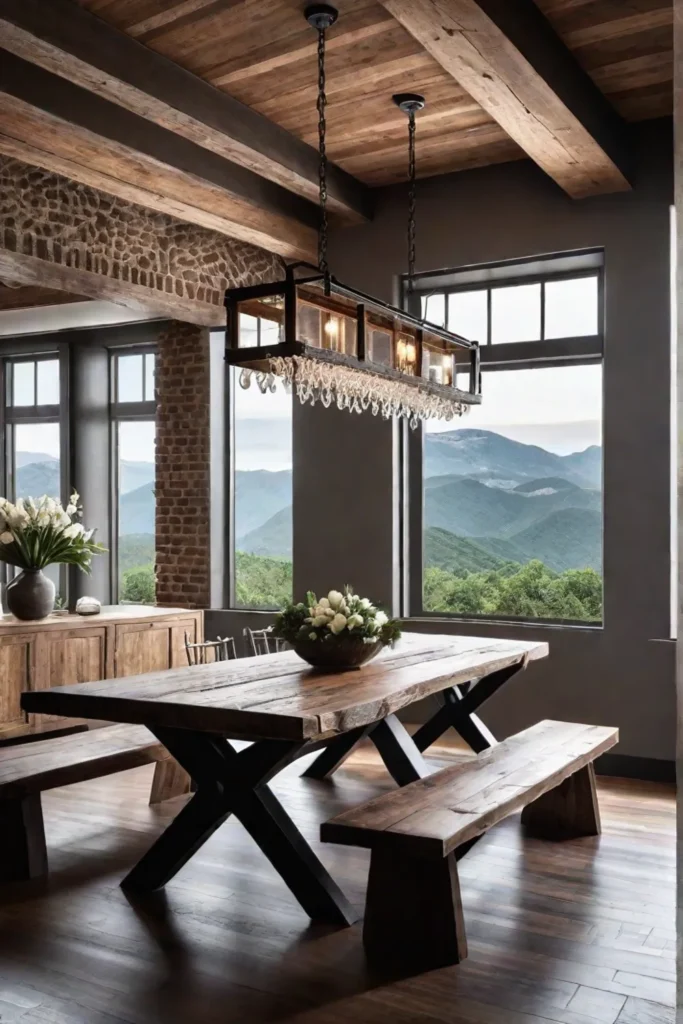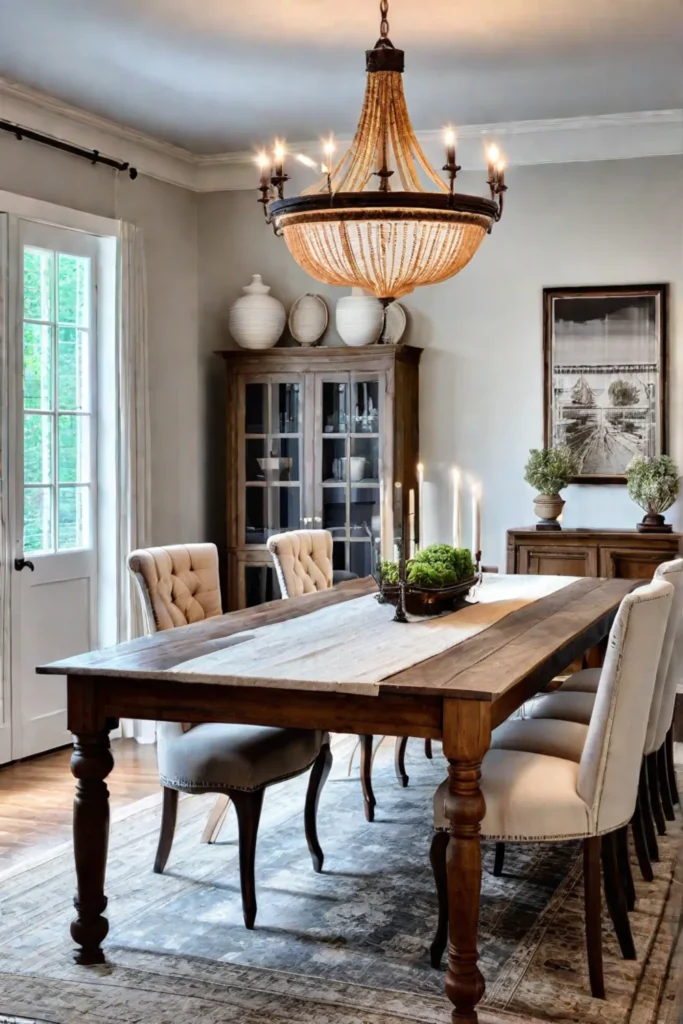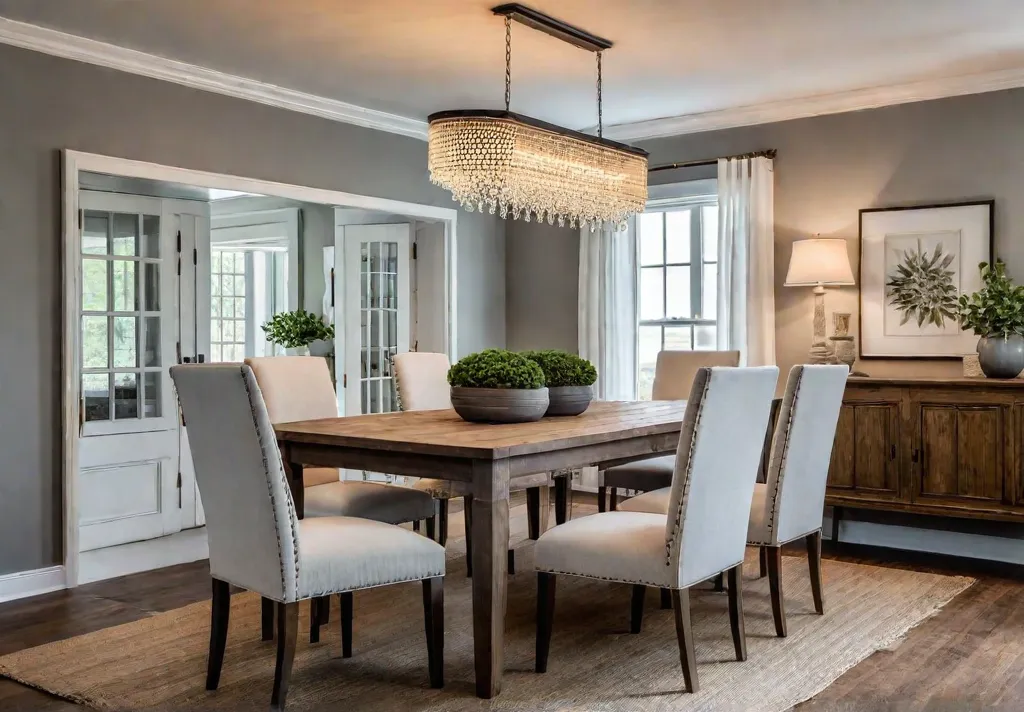You know that feeling when you step into a space and just… exhale? A friend’s dining room, maybe, where the light feels warm and the whole room seems to wrap you in a gentle hug. That’s the magic of a well-composed, farmhouse-inspired space. It’s a feeling of home, distilled.
But here’s the secret: that effortless charm isn’t accidental. It’s a deliberate composition. It’s less about a specific shopping list and more about the thoughtful curation of every piece that inhabits the room—the chairs that pull you in, the lighting that sets the mood, the art that tells your story, and the simple, organic touches that make it all breathe.

So, let’s walk through it. Think of yourself not just as a decorator, but as the curator of your own home. We’re going to build a dining room that’s not just a place to eat, but a place where you’ll want to linger, where stories are shared, and memories are made. Honestly, you’ll be inventing reasons to have people over.
The Art of the Seat: Your Chairs are Everything
Let’s be honest, chairs are often an afterthought. But in a farmhouse dining room? They’re the supporting cast that can steal the show. These aren’t just for sitting; they’re the primary objects that establish that perfect blend of rustic structure and soft invitation. I always look for chairs with a story—a bit of distressed wood, a classic spindle-back silhouette, or simple upholstery in natural, earthy linens.
Now, here’s where we can break the rules. You absolutely do not need a matching set. In fact, please don’t. A room feels so much more authentic when it looks like it was assembled over time. It gives the space a sense of history, even if you just bought everything last week.

I once worked with a client who was terrified of mismatching. We found two incredible, upholstered host chairs for the ends of her long pine table. Then, for the sides, we hunted for weeks at flea markets and online auctions, gathering four different—but complementary—Windsor-style chairs. Each had a slightly different patina, a different story. The final room felt so dynamic and personal. The chairs became conversation starters, each with its own quiet personality.
Let There Be Light: Sculpting the Atmosphere
In the gallery world, we’re obsessed with lighting. We use it to guide the eye, to create emotion, to make a simple white wall feel profound. Your dining room deserves that same attention. Here, lighting isn’t just about seeing your food; it’s about sculpting the entire atmosphere of the room.

That warm, inviting glow you’re after often comes from fixtures with a bit of industrial or rustic soul. Think chandeliers and pendants in aged metals or with simple, almost utilitarian forms. They have a vintage character that’s like a shortcut to that cozy-chic feeling.
But placement and scale are where the real artistry comes in. A dramatic, oversized chandelier hanging low over the dining table? It’s not just a light; it’s an anchor for the whole room, a piece of sculpture. It instantly creates a sense of occasion. For a more modern take, a cluster of simple pendants hung at varying heights can feel really dynamic and fresh.
And please, don’t neglect your walls. Sconces are your secret weapon. They wash the walls in ambient light, making the entire room feel softer and larger. Imagine a warm glow catching the texture of a plaster wall or highlighting a piece of art. That’s how you build layers of light, and layers are what make a space feel rich and truly designed.

The Foundation: Grounding Your Space with a Rug
A rug in the dining room does so much heavy lifting. It’s the visual anchor that grounds the entire arrangement of table and chairs, defining it as a distinct space. It also absorbs sound and, of course, adds a layer of texture and warmth that’s just essential for that farmhouse comfort.
The best choices are almost always natural fibers. Jute, sisal, or a low-pile wool rug offer organic texture and patterns that feel right at home with the farmhouse aesthetic. Their slight imperfections are part of the charm.

Now, for a practical tip on sizing. Here’s a rule of thumb I always share: make sure the rug extends at least 24 inches past the edge of your table on all sides. Why? So that when you pull a chair out to sit down, the legs don’t get caught on the edge of the rug. It’s a small detail that makes a huge difference in how the room functions and feels. It creates a cohesive, intentional zone for dining. And if you’re feeling bold, try layering a smaller, more decorative rug over your larger base rug. It’s an old designer trick that adds instant depth and a collected, worldly vibe.
On the Walls: Curating Your Personal Story
This is where you really get to be the curator. Your walls are blank canvases, and what you choose to hang on them transforms a room from a “farmhouse-style dining room” into your farmhouse-style dining room. The options are limitless, from a full-blown gallery wall to a few thoughtfully placed rustic shelves.

The key is intentionality. Don’t just fill space. I beg you. Every single thing on your wall should be something you love to look at. A gallery wall is a fantastic way to do this. But instead of generic “Live, Laugh, Love” signs, think more personally. Frame a collection of architectural sketches from a trip, a series of black-and-white family photos, or even vintage botanical prints. It’s a way to tell a visual story about who you are.
If you lean more minimalist, a couple of floating raw-wood shelves can be beautiful. Style them with a few pieces of pottery from a local artist, a stack of old books, and a small, trailing plant. These organic, simple objects bring so much character without creating clutter. They offer a moment for the eye to rest and appreciate a small, beautiful detail.
The Center of it All: The Tablescape
The dining table is the heart of the room, but even the most beautiful table can feel a bit empty without a centerpiece to bring it to life. Think of your centerpiece as a small, temporary installation that can change with the seasons, your mood, or what’s for dinner.

The most successful centerpieces connect back to nature. A branch of eucalyptus in a simple ceramic vase, a bowl of seasonal fruit, or a rustic wooden dough bowl filled with moss and candles. These pieces add a focal point that feels both organic and intentional.
But here’s the thing—it has to be functional. There’s nothing worse than a towering floral arrangement that you have to peer around to talk to the person across from you. Keep it low. One of my go-to solutions is a long, narrow wooden tray or a linen runner. You can arrange a few small items—a couple of bud vases, some candles, a small plant—down the center. It feels curated and stylish but leaves plenty of room for passing the mashed potatoes. It’s the farmhouse way: beautiful and practical.
Woven In: The Power of Textiles and Accents
The final layers are often the softest. Textiles and accents are what make a room feel finished and inviting. Think of a soft linen throw draped over the back of a host chair, or a beautiful set of cotton napkins. These are the elements that add touchable warmth and texture.

Natural fibers are your best friend here. Cotton, linen, and wool in neutral shades or with subtle, vintage-inspired patterns complement the aesthetic perfectly. They give off a welcoming vibe that makes guests feel comfortable enough to lean back, get cozy, and stay a while.
And these accents can—and should—be purposeful. That beautiful woven basket in the corner isn’t just for looks; it can hold extra blankets or a stack of magazines. A piece of pottery on a sideboard can house wooden spoons or serve as a wine chiller. When your accent pieces are both beautiful and useful, they contribute to a space that feels genuinely lived-in, not just staged. These small choices are what make a house feel like a cherished home.
An Ode to Honest Materials
A core principle of farmhouse design, at its best, is a deep respect for natural textures and raw materials. There’s an honesty in exposed wood beams, a stone accent wall, or a well-worn wooden tabletop that simply can’t be faked. These elements give a room a sense of history and soul.

Look for opportunities to introduce these textures in both big and small ways. A live-edge wooden serving board can bring a rustic touch to your tablescape. A simple, hand-thrown ceramic pitcher feels more special than a mass-produced one.
And think about layering these textures. A smooth, cool slate cheeseboard on top of a nubby, woven linen placemat creates a wonderful tactile contrast. Running your hand over the grooved surface of a reclaimed wood table while sitting on a smooth, upholstered chair—that’s a sensory experience that makes a room feel alive.
It’s not about turning your dining room into a literal barn. It’s about balance. A simple woven wall hanging can add a powerful tactile moment and serve as a stunning focal point. A few potted herbs on the windowsill infuse the space with life and fragrance, connecting your home to the garden just outside. When you let nature be your design partner, the results are always more authentic.

Tying It All Together: It’s About the Flow
Ultimately, creating a truly magnetic farmhouse dining room is an exercise in cohesive curation. It’s about choosing each individual element—from the largest table to the smallest salt cellar—and ensuring they all work together in a way that feels harmonious and uniquely you.
But it’s more than just looks. Step back and consider the flow. How will people move through the space? Does the furniture arrangement encourage intimate conversation or does it feel formal and stiff? A great room isn’t just beautiful to look at; it feels good to be in.

As you build your room, play with layering textures and materials to create visual depth. Don’t be afraid to experiment with scale—let one large piece of art be the star, while smaller accents play a supporting role. And most importantly, have fun with it. Scour flea markets, support local artists, and let go of the need for perfection.
True farmhouse style is a celebration of the imperfect, the lived-in, and the well-loved. The most captivating dining rooms I’ve ever been in weren’t pulled from a catalog; they were a direct reflection of the people who gathered there. They were home.






